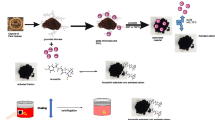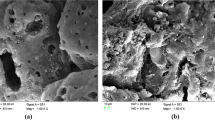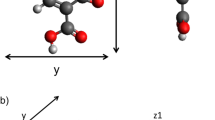Abstract
Three activated carbons were used in this study, two prepared samples and a commercial activated carbon. The activated carbons were issued from date pits and prepared by thermal activation using carbon dioxide. The characterization of the prepared and commercial activated carbons was obtained by N2 and CO2 adsorption at −196 °C and 0 °C, respectively. The adsorption of amoxicillin from aqueous solutions was studied by batch method. Kinetics and isotherms experiments were studied in order to establish the equilibrium time and adsorption capacity of the three activated carbons. Three isotherm equations, Freundlich, Langmuir and Sips, were applied for modelling the adsorption isotherms by non-linear method. Date pits activated carbons achieved high specific area and adsorption capacity of amoxicillin. The removal of this antibiotic was favoured at acidic solution and the physisorption dominated the adsorption mechanism at low pH.





Similar content being viewed by others
References
Addoun A, Bencheikh W, Temdrara L, Belhachemi M, Khelifi A (2014) Adsorption behavior of phenol on activated carbons prepared from Algerian coals. Desalin Water Treat 52:1–9
Al-Gheethi AAS, Ismail N (2014) Biodegradation of pharmaceutical wastes in treated sewage effluents by Bacillus btilis 1556WTNC. Environ. Process. 1:459–481
Andreozzi R, Canterino M, Marotta R, Paxeus N (2005) Antibiotic removal from wastewaters: the ozonation of amoxicillin. J Hazard Mater 122(3):243–250
Belgacem A, Rebiai R, Hadoun H, Khemaissia S, Belmedani M (2014) The removal of uranium (VI) from aqueous solutions onto activated carbon developed from grinded used tire. Environ Sci Pollut Res 21:684–694
Belhachemi M, Addoun F (2011) Effect of heat treatment on the surface properties of activated carbons. E-Journal of Chemistry 8(3):992–999
Benotti M, Trenholm R, Vanderford BJ, Holady J, Stanford B, Snyders S (2009) Pharmaceuticals and endocrine disrupting compounds in U.S. drinking water. Environ Sci Technol 43:597–603
Björklund K, Li LY (2017) Adsorption of organic storm water pollutants onto activated carbon from sewage sludge. Journal of Environmental Management197: 490–497
Bouchemal N, Belhachemi M, Merzougui Z, Addoun F (2009) The effect of temperature and impregnation ratio on the active carbon porosity. Desalin Water Treat 10:115–120
Brown KD, Kulis J, Thomson B, Chapman TH, Mawhinney DB (2006) Occurrence of antibiotics in hospital, residential, and dairy effluent, municipal wastewater, and the Rio Grande in New Mexico. Sci Total Environ 366:772–783
Chayid MA, Ahmed MJ (2015) Amoxicillin adsorption on microwave prepared activated carbon from Arundo donax Linn: isotherms, kinetics, and thermodynamics studies. J Environ Chem Eng 3:1592–1601
Fierro V, Torné-Fernández V, Montané D, Celzard A (2008) Adsorption of phenol onto activated carbons having different textural and surface properties. Micropor Mesopor Mater 111:276–284
Girish CR, Murty VR (2015) Adsorption of phenol from aqueous solution using Lantana camaraf Forest waste: packed bed studies and prediction of breakthrough curves. Environ Process 2:773–796
Gregg SJ, Sing KSW (1982) Adsorption, surface and porosity. Academic Press, London
Hamdaoui O, Naffrechoux E (2007) Modeling of adsorption isotherms of phenol and chlorophenols onto granular activated carbon. Part I Two-parameter models and equations allowing determination of thermodynamic parameters Journal of Hazardous Materials 147:381–394
Hartmann J, Beyer R, Harm S (2014) Effective removal of estrogens from drinking water and wastewater by adsorption technology. Environ Process 1:87–94
Ho YS (2006) Review of second-order models for adsorption systems. J. Haz Mater B136:681–689
Ho YS, McKay G (1999) Pseudo-second order model for sorption processes. Process Biochem 34:451–465
Hughes SR, Kay P, Brown LE (2016) Impact of anti-inflammatories, beta-blockers and antibiotics on leaf litter breakdown in freshwaters. Environ Sci Pollut Res 23(4):3956–3962
Lagergren S (1898) About the theory of so-called adsorption of soluble substances, Kungliga Svenska Vetenskapsakademiens. Han-dlingar, Band 24:1–39
Lavniewski A, de_Korwin JD, Muhale F, Jehl F (1998) Gastric diffusion of antibiotics used against helicobacter pylori. Int J Antimicrob Agents 9: 181–193.
Li S, Li X, Wang D (2004) Membrane (RO-UF) filtration for antibiotic wastewater treatment and recovery of antibiotics. Sep Purif Technol 34:109–114
Limousy L, Ghouma I, Ouederni A, Jeguirim M (2016) Amoxicillin removal from aqueous solution using activated carbon prepared by chemical activation of olive stone. Environ Sci Pollut Res 24:9993–10004
Mansouri H, Carmona RJ, Gomis-Berenguer A, Souissi-Najar S, Ouederni A, Ania CO (2015) Competitive adsorption of ibuprofen and amoxicillin mixtures from aqueous solution on activated carbons. J Colloid Interface Sci 449:252–260
March H, Rodríguez-Reinoso F (2006) Activated carbon. Elsevier, Amsterdam
Órfão JJM, Silva AIM, Pereira JCV, Barata SA, Fonseca IM, Faria PCC, Pereira MFR (2006) Adsorption of a reactive dye on chemically modified activated carbons-influence of pH. Colloid and Interf Sc 296:480–489
Pan X, Deng C, Zhang D, Wang J, Mu G, Chen Y (2008) Toxic effects of amoxicillin on the photosystem II of Synechocystis sp. characterized by a variety of in vivo chlorophyll fluorescence tests. Aquat Toxicol 89(4):207–213
Putra EK, Pranowo R, Sunarso J, Indraswati N, Ismadji S (2009) Performance of activated carbon and bentonite for adsorption of amoxicillin from wastewater: mechanisms, isotherms and kinetics. Water Res 43(9):2419–2430
Rodríguez-Reinoso F (1998) Molina-Sabio M. Textural and chemical characterization of microporous carbons Advances in Colloid and Interface Sci 77:271–294
Schwartz T, Kohnen W, Jansen B (2003) Detection of antibiotic-resistant bacteria and their resistance genes in wastewater, surface water, and drinking water biofilms. FEMS Microbiol Ecol 43:325–335
Sedghi S, Hadi Madani S, Hu C, Silvestre-Albero A, Skinner W, Kwong P, Pendleton P, Smernik RJ, Rodríguez-Reinoso F, Biggs MJ (2015) Control of the spatial homogeneity of pore surface chemistry in particulate activated carbon. Carbon 95:144–149
Şencan A, Karaboyacı M, Kılıç M (2015) Determination of lead (II) sorption capacity of hazelnut shell and activated carbon obtained from hazelnut shell activated with ZnCl2 Environ Sci Pollut res 22: 3238–3248
Shafeeyan MS, Wan Wan Daud MA, Houshmand AH, Shamiri A (2010) A review on surface modification of activated carbon for carbon dioxide adsorption. J Anal Appl Pyrolysis 89:143–151
Silvestre-Albero A, Silvestre-Albero J, Sepúlveda-Escribano A, Rodríguez-Reinoso F (2009) Ethanol removal using activated carbon: effect of porous structure and surface chemistry. Microporous Mesoporous Mater 120:62–68
Tahar A, Choubert JM, Miège C, Esperanza M, Le Menach K, Budzinski H, Wisniewski C, Coquery M (2014) Removal of xenobiotics from effluent discharge by adsorption on zeolite and expanded clay: an alternative to activated carbon?. Environ Sci Pollut Res 21 (8):5660–5668
Trovó AG, Melo SAS, Nogueira RFP (2008) Photodegradation of the pharmaceuticals amoxicillin, bezafibrate and paracetamol by thephoto-Fenton process—application to sewage treatment plant effluent. J Photochem Photobiol Chem 198(2–3):215–220
Volkmann H, Schwartz T, Bischoff P, Kirchen S, Obst J (2004) Detection of clinically relevant antibiotic-resistance genes in municipal wastewater using real-time PCR (man) Microbiol. Methods 56:277–286
WHO (2015) Antibiotics resistance. World Health Organization, Geneva
Xu WH, Zhang G, Zou SC, Li XD, Liu YC (2007) Determination of selected antibiotics in the Victoria harbour and the Pearl River, South China using high performance liquid chromatography electrospray ionization tandem mass spectrometry. Environ Pollut 145:672–679
Author information
Authors and Affiliations
Corresponding author
Rights and permissions
About this article
Cite this article
Belhachemi, M., Djelaila, S. Removal of Amoxicillin Antibiotic from Aqueous Solutions by Date Pits Activated Carbons. Environ. Process. 4, 549–561 (2017). https://doi.org/10.1007/s40710-017-0245-8
Received:
Accepted:
Published:
Issue Date:
DOI: https://doi.org/10.1007/s40710-017-0245-8




